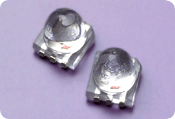Agilent Technologies has introduced a high-brightness AlInGaP-based orange 612nm LED specifically designed to provide the illumination required to operate the automatic focus function of a digital still camera under low-light conditions. Most cameras use an infrared LED for this function, although some already use visible devices.
With a typical light output of 18 candela (at 20 mA), Agilent says that the ASMT-FJ10 is the brightest auto-focus LED on the market. The device operates over a range up to 3 meters, and has a footprint of 4.8x 4.8 mm with a height of 5.33 mm, which the company claims is the industry's smallest package footprint.
The auto-focus function uses light to detect the distance from the camera to the subject, and focuses the camera accordingly. In normal conditions, ambient (visible) light is used but in low-light conditions an additional light source is required.
In the past, cameras used IR-emitting LEDs for auto-focusing under low-light conditions because these were the only devices with sufficient light output. However, this means that a separate auto-focus sensor is required to detect the IR radiation.
The use of a visible-light emitter means that the same auto-focusing sensor is used under both low-light and ordinary conditions.
Since the orange 612nm LED provides visible illumination, the same device can also be used as a red-eye reduction lamp and serve as an indicator that the camera's self-timer is operating.
According to Patrick Trueson, Agilent's European Product Marketing Manager, the next generation of devices will be InGaN green LEDs with a minimum luminous intensity of 10 cd (at 20 mA). "Green light corresponds more closely with the sensitivity of the camera," he says.
The Agilent ASMT-FJ10 is a lead-free SMT dome lamp using an optimized untinted, non-diffused lens to provide a high luminous intensity with a narrow 8-degree radiation pattern (half-value angle). The molded package is compatible with lead-free IR (infrared) soldering processes.
When installed in a camera without additional collimating optics these LEDs meet the Class 1 eye-safety requirements of IEC/EN 60825-1 (2001) under all conditions of operation and single fault failure.







